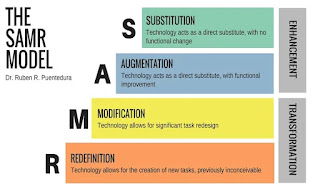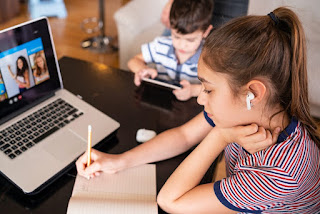Framework Self-Evaluation
This week I am taking a closer look into the world of technology that I use in the Special Education Resource room under the SAMR Model developed by Ruben Puentedura in 2010, an education researcher.
 |
| Image Source: edutopia.org |
What is the SAMR Model?
There are four different layers of SAMR - Substitution, Augmentation, Modification, and Redefinition. This framework assists educators in seeing how they are using technology in the classroom and how they are helping to examine the level in which students are learning with the the technology.
Substitution focuses on something that can be done digitally instead of on paper. For example, a student uses an online dictionary versus going to a shelf in the classroom to use a traditional dictionary. This is honestly something that I resort to today in the classroom. How many teachers still have paper dictionaries in their classroom?
Augmentation focuses on the technology being the substitute adding upgraded features to the student's learning experience. For instance, a teacher uses an online quiz app such as Kahoot that provides feedback instantly for the student to find out what they need to focus their studies on when they are stuck on a particular topic or concept.
Modification is where technology is used to redesign parts of a task using different digital tools which will enhance student's learning. An example of this is a teacher uses a YouTube video during a lesson to help students understand the material.
Redefinition is where the transformation begins. Technology is used to design and create new tasks that goes beyond just simple pencil and paper. An example of redefinition is an App called SnapType. The App allows a student who struggles with handwriting to keep up with any assignment in the classroom freeing the teacher to help other students or to continue teaching the lesson.
Where do I fall in SAMR?
This question is something I pondered on for awhile as I am not a teacher. My focus is from my perspective as a teacher's aide and what is being used in the classroom. I do not plan the lesson plans or what is being done in the classroom. I am able to make suggestions as I observe what works and what does for the students we work with.
SAMR, overall, in my opinion definitely appears in the classroom. Most of the work we do in the classroom is hands on and still mostly on paper. Yes, we do have iPads in the room, but not enough for the number of students we teach. We also have use of a Smart Board. I would say that we would be right along the line of Augmentation and Modification. For the third grade students, Language Arts worksheets are scanned and displayed on the Smart Board for instruction and discussion. Students get an opportunity to come up and answer questions as we go through the worksheet as a group. The discussion and having the opportunity to come up gives the student a chance to not only move around, but to keep the students engaged. In addition, instruction includes resources from YouTube that includes animation and music like Jack Hartmann to help with language and Math.
When we do use the iPads, we use it for time in which the students have a book read to them through Learning Ally . This allows the Special Education Resource Teacher and I to provide support for other students that come into the classroom for support. The books are assigned based on their interests and gives them an opportunity to listen to books they normally would pick out on their library day.
 |
| Image Source: learningally.org |
Where Special Education Resources could be?
The technology we do use in the classroom is limited, but my hope is that the school district provides more funds for the special education budget to provide useful resources to help engage students. The struggle right now is limited resources to use due to budget. Funds for more iPads to accommodate the students we serve would help in assisting students in language, communication, and in their everyday life as they move through school.
Students in Special Education deserve an education just like students in general education. Resources like SnapType would allow students to keep up with their class and on assignments in the classroom. I can not even begin to tell you how much time is spent taking notes down for three students at the same time during a Social Studies or Science lesson. This technology would help them grow confidence and not feel like they are holding their teacher back from teaching. In addition, some sort of virtual reality technology would be great to assist students in being able to adjust to different environments and activities in the school. Students that are in the classroom are different and just do not know how to be around others. I feel like students are always excluded because of their abilities in school. Why not build their confidence in learning new skills in an environment where they can be comfortable in? Overall, these are just some of the technologies that would benefit special education students.
Resources:
Terada, Y. (2020, May 4). A powerful model for understanding good tech integration. Edutopia. https://www.edutopia.org/article/powerful-model-understanding-good-tech-integration

Technology can do wonders to level the playing field in education. Hopefully, funding will become available.
ReplyDeleteNicole, you are right on that. I got to say being an aide has definitely given me a perspective on how hard teachers work and really understanding they dynamics of different classrooms.
Delete